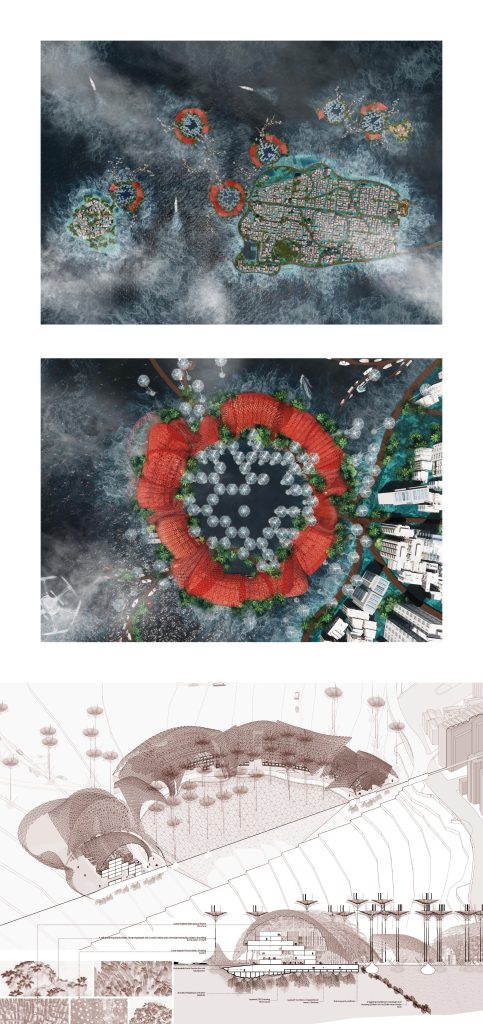Noohuru: Reclaiming the Oceanscape – Babin Babu Kunnummal’s Vision for a Regenerative Maldives
Reimagining Resilience on Sinking Shores
With rising sea levels threatening the very existence of island nations, architects are increasingly challenged to envision radical strategies for adaptive living. Among those leading the charge is Babin Babu Kunnummal—a multidisciplinary architectural professional whose latest project, Noohuru – The Restoration of Life and Healing of the Ocean, is charting new waters in speculative, regenerative design. Currently completing his MArch at the University of Greenwich, Babin combines his dual academic background in Architecture and Civil Engineering with over six years of hands-on experience across India, Qatar, and the UK. His portfolio stands as a testament to an ethos rooted in sustainability, adaptability, and a relentless pursuit of spatial justice.
A Blueprint for Reconciliation with Nature
At the heart of Noohuru lies a fundamental question: how can architecture catalyse not just human survival, but the restoration and prosperity of fragile ecosystems? Babin’s proposal is a response to the acute vulnerability of the Maldives, a nation where the highest natural point barely rises above sea level. Rather than viewing the archipelago’s predicament as an unsolvable crisis, Babin reframes the narrative, treating rising tides as an opportunity for innovation and coexistence. His solution draws deeply from local wisdom—embodying atoll logic and the self-organising, mutually supportive systems seen in coral reef ecologies.
Coral-Led Urbanism: The Power of Ecological Analogies
Inspired by the complex, adaptive structures of coral reefs, Noohuru proposes a decentralized, lattice-like network of habitats. These are designed to grow, evolve, and regenerate in direct collaboration with their oceanic context. The architectural language is fluid: modular units are buoyant, flexible, and capable of expansion alongside reef health and population needs. In a marked departure from monolithic flood defences, each community node interlocks with living marine structures—encouraging both biodiversity and social cohesion.
Environmental stewardship is not relegated to aesthetics or technical add-ons; it is woven into the fabric of the architecture itself. Each cluster integrates coral seeding platforms, tidal energy harvesting, and systems for water remediation, establishing a subtle feedback loop that gradually improves its own ecological baseline. The boundary between the built and unbuilt, between human and more-than-human communities, is deliberately blurred.
Craft, Culture, and Community Resilience
Babin’s design draws on the indigenous architectural heritage of Maldivian communities—adapting traditional materials and forms, such as locally sourced timber and palm thatch, to contemporary performance standards. The project respects the spatial rituals and everyday practices of the islands’ residents while interweaving innovations in material science and engineering. Communal spaces are placed at the heart of each floating module, fostering collective agency in decision-making and ecosystem stewardship.
Far from a remote, techno-centric vision, Noohuru is deeply invested in the social and cultural tapestry of the region. Spaces for gathering, learning, and ceremony ensure the preservation and reinvention of identity as environmental realities shift. The design celebrates resilience as an emergent property—not only of infrastructures, but of people and places in active dialogue with a changing planet.
Pushing the Boundaries: Research-Driven and Recognised
Babin’s approach is analytically rigorous, underpinned by research into marine biology, hydrology, and geoengineering. He leverages his civil engineering expertise to anticipate the structural demands of oceanic living, and deploys parametric tools to simulate the evolving interplay between modules, currents, and marine growth. This process is not merely speculative; it is grounded in a pragmatic assessment of material lifecycles, maintenance, and the economic viability of large-scale implementation.
While still a proposal, Noohuru has already attracted attention within academic and professional circles for its synthesis of research and radical imagination. The project exemplifies how architectural inquiry—when coupled with lived experience and technical depth—can yield solutions as poetic as they are practical.
A Philosophy of Spatial Justice and Environmental Repair
Central to Babin’s philosophy is the conviction that architecture must serve as a conduit for environmental repair and spatial justice. This is not just about resilience in the face of climate change, but about fostering new ethics of care and reciprocity between land, water, and culture. Noohuru is imbued with this ethos: its modularity encourages bottom-up participation, its systems are purpose-built for adaptation and regeneration, and its vision for the Maldives transcends mere preservation to propose a genuinely hopeful future.
Connect and Collaborate: Be Part of the Dialogue
As oceans rise and the boundaries of architecture expand, the work of practitioners like Babin Babu Kunnummal invites us all to reimagine the relationship between design, community, and ecology. Noohuru is more than a floating city—it’s a blueprint for the restoration of life, inviting architects, researchers, and stakeholders to join the conversation.
To connect with Babin or learn more about his work, you can reach him on LinkedIn or via email at babinbabuk@gmail.com. Whether you are a fellow designer, student, academic, or policy advocate, Babin welcomes collaboration and critical dialogue as we collectively shape the future of coastal and oceanic habitats.
Images and diagrams of Noohuru, alongside Babin’s research collateral, are available on request. For deeper insight into his design process or to discuss potential partnerships, don’t hesitate to get in touch.
This feature was written for the Architecture Social—where emerging visionaries and established professionals come together to share ideas for a more adaptive, sustainable world.







Add a comment